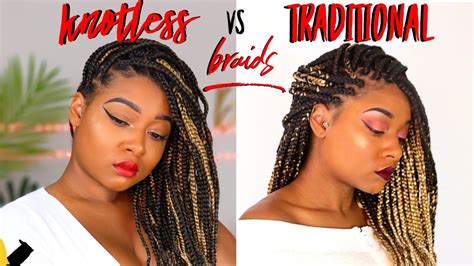Introduction
When it comes to protective hairstyles, box braids and knotless braids stand as two popular contenders. Both offer versatility, longevity, and a stylish touch. However, subtle differences between these two techniques can influence your choice. This comprehensive guide delves into the intricacies of box braids vs. knotless braids, equipping you with the knowledge to make an informed decision that aligns with your hair goals and preferences.

Defining Box Braids and Knotless Braids
-
Box Braids: Classic box braids are created by sectioning hair into square or rectangular-shaped sections and braiding them tightly against the scalp. The result is a sleek, geometric look that can last several weeks.
-
Knotless Braids: Knotless braids adopt a different approach, eliminating the knots traditionally used to secure braids. Instead, they rely on a unique feed-in method where hair is added continuously as the braid is formed. This results in a less bulky and more natural-looking style.
Comparing Box Braids vs. Knotless Braids: Key Characteristics
1. Installation Time and Effort
-
Box Braids: The installation of box braids typically takes longer due to the intricate sectioning and knotting process.
-
Knotless Braids: Knotless braids require less time and effort to install, thanks to their continuous feed-in method.
2. Scalp Tension and Comfort
-
Box Braids: Box braids can cause more tension on the scalp, especially if they are pulled too tightly.
-
Knotless Braids: Knotless braids distribute weight more evenly, reducing scalp tension and enhancing comfort.
3. Appearance and Volume
-
Box Braids: The tight braiding technique of box braids results in a more structured and uniform appearance.
-
Knotless Braids: Knotless braids offer a softer, more voluminous look with less bulk at the roots.
4. Longevity and Maintenance
-
Box Braids: Box braids can last for 6-8 weeks or longer with proper care.
-
Knotless Braids: Knotless braids typically have a lifespan of 4-6 weeks due to their looser nature.
5. Cost and Stylist Availability
-
Box Braids: Box braids are generally more affordable and widely offered by stylists.
-
Knotless Braids: Knotless braids may require specialized skills and can be more expensive.
Advantages and Disadvantages of Box Braids vs. Knotless Braids:
Advantages of Box Braids
-
Long-lasting and versatile
-
Suitable for various hair textures
-
Enhances hair growth and reduces shedding
Disadvantages of Box Braids
-
Can cause scalp tension
-
Time-consuming to install
-
Higher risk of breakage if not installed properly
Advantages of Knotless Braids
-
Reduces scalp tension and discomfort
-
Shorter installation time
-
More natural-looking appearance
Disadvantages of Knotless Braids
-
Shorter lifespan
-
May not be suitable for all hair textures
-
Requires specialized skills to install
Choosing the Right Option: Factors to Consider
The best choice between box braids and knotless braids depends on individual preferences and circumstances. Consider the following factors:
-
Scalp sensitivity: Knotless braids are ideal for individuals with sensitive scalps.
-
Hair texture: Box braids are suitable for all hair textures, while knotless braids may work better for finer hair.
-
Style goals: Box braids offer a structured look, while knotless braids provide a softer, voluminous appearance.
-
Longevity: Box braids last longer, while knotless braids require more frequent touch-ups.
Common Mistakes to Avoid
-
Overtightening braids: Avoid pulling braids too tightly, as this can damage hair and cause scalp discomfort.
-
Neglecting maintenance: Regular shampooing, conditioning, and moisturizing are crucial for maintaining the health of braided hair.
-
Using harsh chemicals: Avoid harsh products that can strip hair of its natural oils and lead to breakage.
-
Sleeping without a satin cap: Protect braids from friction and tangling by wearing a satin cap at night.
Why Box Braids or Knotless Braids Matter: Understanding the Benefits
-
Hair Protection: Braiding helps shield hair from environmental factors, reducing breakage and split ends.
-
Versatility and Style: Box and knotless braids offer numerous styling options, from buns and ponytails to intricate updos.
-
Reduces Styling Time: Braided hair eliminates the need for daily styling, saving time and effort.
-
Promotes Hair Growth: Braiding can reduce manipulation and tension on hair, promoting healthy growth and length retention.
Frequently Asked Questions (FAQs)
-
Can I wash braided hair? Yes, it is essential to wash braided hair regularly to remove product buildup and dirt.
-
How often should I get my braids retouched? Re-tightening is recommended every 3-4 weeks for box braids and 2-3 weeks for knotless braids.
-
Can braids damage my hair? If installed and maintained properly, braids will not damage hair.
-
Which style is more suitable for natural hair? Both box braids and knotless braids are appropriate for natural hair textures.
-
Can I braid my own hair? While self-braiding is possible, it is recommended to consult a professional stylist for optimal results.
-
Which style offers better protection from hair breakage? Box braids provide stronger protection against breakage due to their tighter construction.
-
Is it possible to switch between box braids and knotless braids? Yes, it is possible to transition between these styles by having them professionally removed and re-installed.
-
Can I dye braided hair? Yes, but it is important to use semi-permanent or temporary hair dye to avoid damaging the hair fibers.
